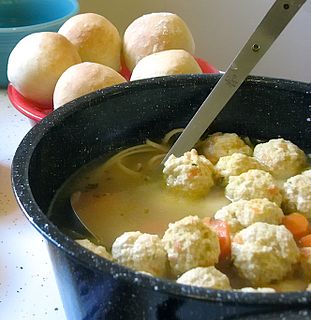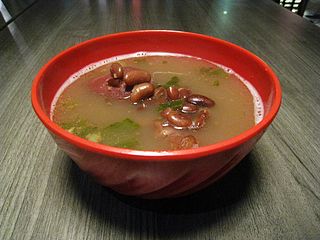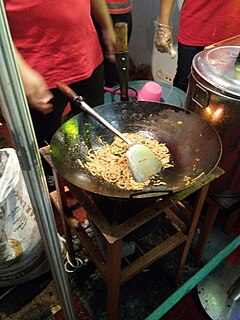
Cajun cuisine, is a style of cooking named for the French-speaking Acadian people deported by the British from Acadia in Canada, incorporating West African, French and Spanish cooking techniques, in region of Louisiana. Cajun cuisine is sometimes referred to as a 'rustic cuisine', meaning that it is based on locally available ingredients and preparation is relatively simple.

Louisiana Creole cuisine is a style of cooking originating in Louisiana, United States, which blends West African, French, Spanish, Amerindian, Haitian influences, as well as influences from the general cuisine of the Southern United States.

Russian cuisine is a collection of the different cooking traditions of the Russian people. The cuisine is diverse, with Northern and Eastern European, Caucasian, Central Asian, Siberian, and East Asian influences. Its foundations were laid by the peasant food of the rural population in an often harsh climate, with a combination of plentiful fish, pork, poultry, caviar, mushrooms, berries, and honey. Crops of rye, wheat, barley and millet provided the ingredients for a plethora of breads, pancakes, pies, cereals, beer and vodka. Soups and stews are centered on seasonal or storable produce, fish and meats. Such food remained the staple for the vast majority of Russians well into the 20th century. Soviet cuisine had a separate character of its own.

Ukrainian cuisine is the collection of the various cooking traditions of the Ukrainian people accumulated over many years. The cuisine is heavily influenced by the rich dark soil (chornozem) from which its ingredients come and often involves many components.
Romanian cuisine is a diverse blend of different dishes from several traditions with which it has come into contact, but it also maintains its own character. It has been mainly influenced by Turkish and a series of European cuisines such as the Austrian cuisine, German cuisine, Greek cuisine, or Hungarian cuisine as well as culinary elements stemming from the cuisines of the Slavic-speaking countries of Eastern and Central Europe.

Czech cuisine has both influenced and been influenced by the cuisines of surrounding countries and nations. Many of the cakes and pastries that are popular in Central Europe originated within the Czech lands. Contemporary Czech cuisine is more meat-based than in previous periods; the current abundance of farmable meat has enriched its presence in regional cuisine. Traditionally, meat has been reserved for once-weekly consumption, typically on weekends. The body of Czech meals typically consists of two or more courses; the first course is traditionally soup, the second course is the main dish, and the third course can include supplementary courses, such as dessert or compote. In the Czech cuisine, thick soups and many kinds of sauces, both based on stewed or cooked vegetables and meats, often with cream, as well as baked meats with natural sauces (gravies), are popular dishes usually accompanied with beer, especially Pilsner, that Czechs consume the most in the world. Czech cuisine is also very strong in sweet main courses and desserts, a unique feature in European cuisines.

Sofrito, sofregit (Catalan), soffritto, or refogado is a sauce used as a base in Latin American, Spanish, Italian and Portuguese cooking. Preparations may vary, but it typically consists of aromatic ingredients cut into small pieces and sautéed or braised in cooking oil.

Lecsó is a Hungarian thick vegetable ragout or stew which features explicitly yellow pointed peppers, tomato, onion, salt, and ground sweet and/or hot paprika as a base recipe. The onions and peppers are usually sauteed in lard, bacon fat or sunflower oil. Garlic can also be a traditional ingredient. It is also considered to be traditional food in Czech, Slovak and Croatian cuisine and is also very common in Poland, Austria, and Israel.

Kazakh cuisine is traditionally focused on mutton and horse meat, as well as various milk products. For hundreds of years, Kazakhs were herders who raised fat-tailed sheep, Bactrian camels, and horses, relying on these animals for transportation, clothing, and food. The cooking techniques and major ingredients have been strongly influenced by the nation's nomadic way of life. For example, most cooking techniques are aimed at long-term preservation of food. There is a large practice of salting and drying meat so that it will last, and there is a preference for sour milk, as it is easier to save in a nomadic lifestyle.
Bukharan Jewish cuisine is the traditional cuisine originating from the Bukharian Jewish community of Central Asia, who now mostly reside in Israel, and the United States.

A meatball is ground meat rolled into a small ball, sometimes along with other ingredients, such as bread crumbs, minced onion, eggs, butter, and seasoning. Meatballs are cooked by frying, baking, steaming, or braising in sauce. There are many types of meatballs using different types of meats and spices. The term is sometimes extended to meatless versions based on vegetables or fish; the latter are commonly known as fishballs.

Mie ayam, mi ayam or bakmi ayam is a common Indonesian dish of seasoned yellow wheat noodles topped with diced chicken meat (ayam). It especially common in Indonesia, Singapore and Malaysia, and can trace its origin to Chinese cuisine. In Indonesia, the dish is recognized as a popular Chinese Indonesian dish, served from simple travelling vendor carts frequenting residential areas, humble street-side warung to restaurants.

Crab in Padang sauce or Padang crab is an Indonesian seafood dish of crab served in hot and spicy Padang sauce. It is one of the two most popular ways that crab is served in Indonesia, commonly found in coastal cities with abundant seafood, such as Padang, Jakarta, Medan, Surabaya, Makassar and Cirebon. Its closest analogue probably is chili crab, however Padang crab uses richer spices.
Calabacitas con puerco is a traditional dish in Mexican cuisine. It consists of pork that is sauteed in butter, oil or in its own fat. Garlic, onion, black pepper, salt and chilis are added, and left on fire until everything is cooked. Chopped red tomato, corn grains, bay leaf, cumin and black pepper is then added. All this is boiled until meat is tender. Missing a few minutes to extinguish the fire, chopped pumpkin or zucchini is added until finely cooked. This dish is usually served with refried beans and red rice.

Dumpling is a broad classification for a dish that consists of pieces of dough wrapped around a filling, or of dough with no filling. The dough can be based on bread, flour or potatoes, and may be filled with meat, fish, cheese, vegetables, fruits or sweets. Dumplings may be prepared using a variety of methods, including baking, boiling, frying, simmering or steaming and are found in many world cuisines.

Sambal is an Indonesian chili sauce or paste typically made from a mixture of a variety of chili peppers with secondary ingredients such as shrimp paste, garlic, ginger, shallot, scallion, palm sugar, and lime juice. Sambal is an Indonesian loan-word of Javanese origin (sambel). It is native to the cuisines of Indonesia, and popular in Malaysia, Sri Lanka, Brunei and Singapore. It has also spread through overseas Indonesian populations to the Netherlands and Suriname.

A stew is a combination of solid food ingredients that have been cooked in liquid and served in the resultant gravy. Ingredients in a stew can include any combination of vegetables and may include meat, especially tougher meats suitable for slow-cooking, such as beef. Poultry, sausages, and seafood are also used. While water can be used as the stew-cooking liquid, stock is also common. Seasoning and flavourings may also be added. Stews are typically cooked at a relatively low temperature, allowing flavours to mingle.

Brenebon soup or bruinebonensoep is a kidney beans soup commonly found in the Eastern Indonesia, more often specifically associated with Manado cuisine of North Sulawesi. The soup is made from kidney beans with vegetables served in broth seasoned with garlic, pepper and other spices.

Indonesian noodles are a significant aspect of Indonesian cuisine which is very diverse. Indonesian cuisine recognised many types of noodles, with each regions often developed their distinct recipes.















